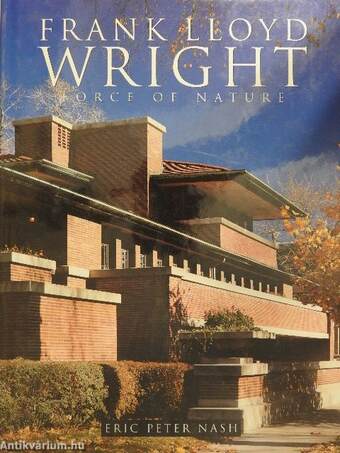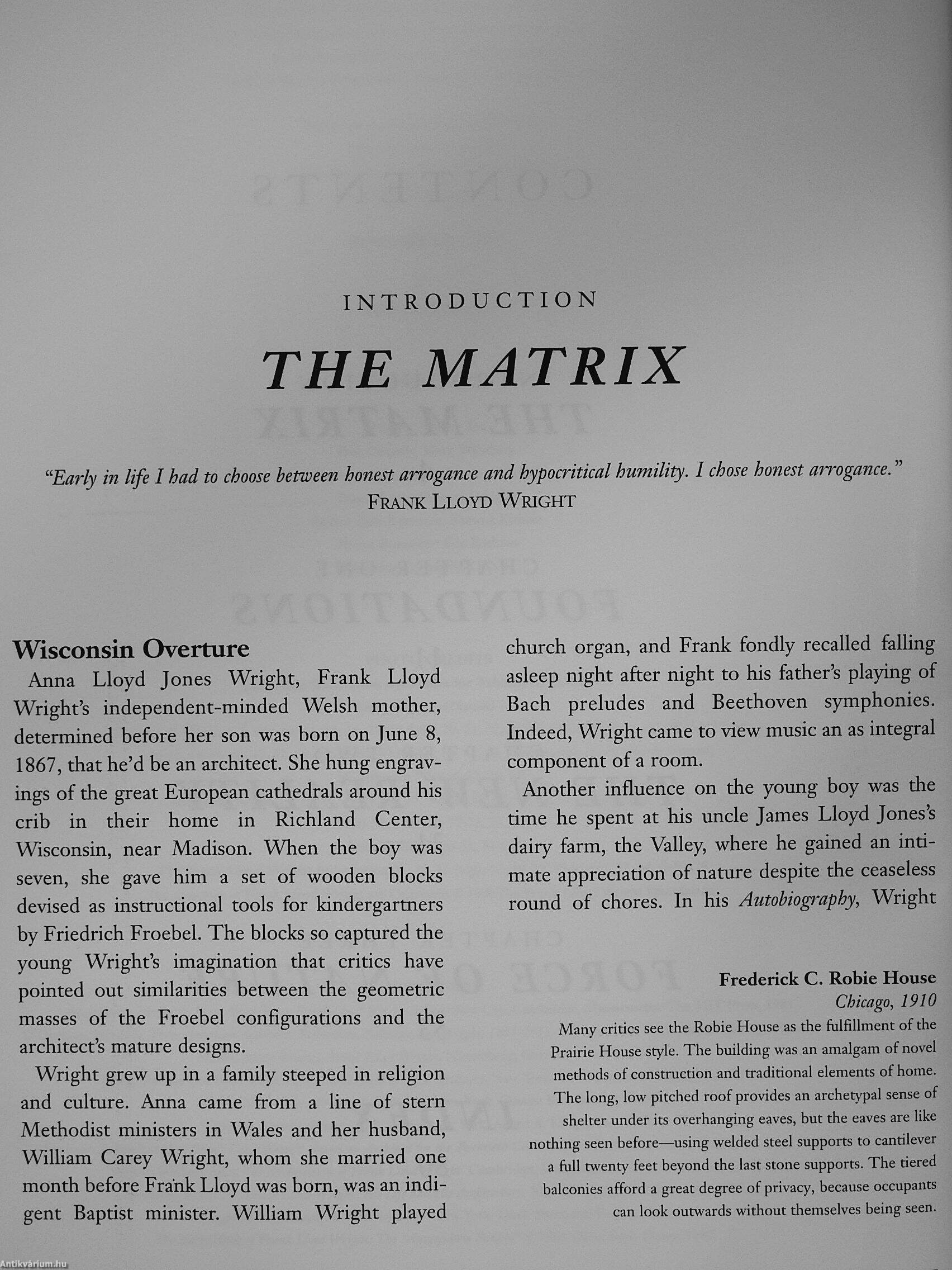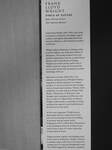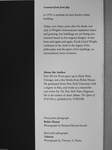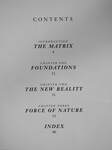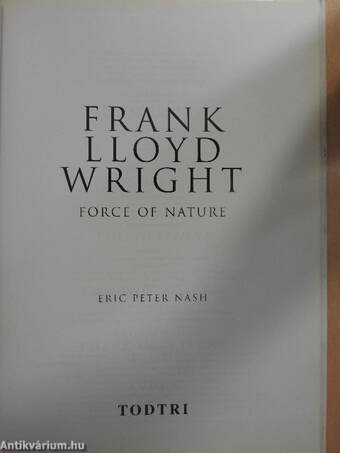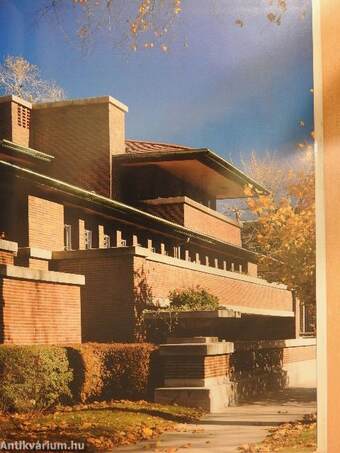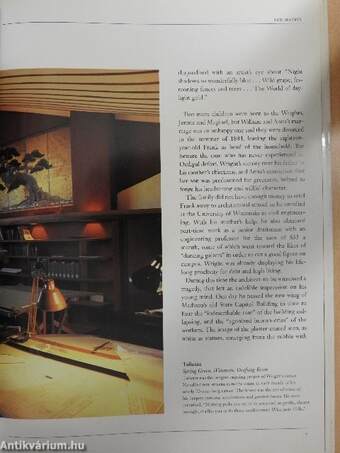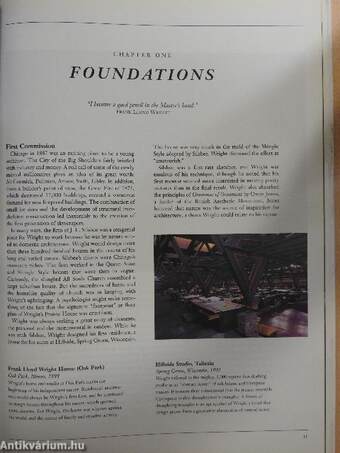1.062.586
kiadvánnyal nyújtjuk Magyarország legnagyobb antikvár könyv-kínálatát

VISSZA
A TETEJÉRE
JAVASLATOKÉszre-
vételek
Frank Lloyd Wright
Force of Nature
| Kiadó: | Todtri Productions Limited |
|---|---|
| Kiadás helye: | New York |
| Kiadás éve: | |
| Kötés típusa: | Fűzött kemény papírkötés |
| Oldalszám: | 80 oldal |
| Sorozatcím: | |
| Kötetszám: | |
| Nyelv: | Angol |
| Méret: | 33 cm x 24 cm |
| ISBN: | 1-880908-0-6 |
| Megjegyzés: | Színes fotókkal. |
naponta értesítjük a beérkező friss
kiadványokról
naponta értesítjük a beérkező friss
kiadványokról
Előszó
TovábbFülszöveg
FRANK LLOYD WRIGHT
FORCE OF NATURE
Eric Peter Nash
With 10 full-colour illustrations
Frank Lloyd Wright (1867-1959) is the avatar of American architecture. His highly original aesthetic and singular philosophy placed him, during his lifetime, in the forefront of modern architecture.
Wright studied architecture in Chicago under Louis H. Sullivan, one of the first builders of skyscrapers. The young architect's first independent constructions were his so-called Prairie Houses, built in the suburbs of Chicago. Wright's turn-of-the-century prairie style is defined in part by a long, low horizontal line and an open interior plan featuring the modern furnishings of the era.
Both before and after World War I, the boldness and innovation of Wright's buildings expanded, as did his reputation as a leading architect. It was also at this time that he began work on his principal residence, Taliesin, which melded his own style with that of Italy's Villa Medici. Taliesin East, in Wisconsin,... Tovább
Fülszöveg
FRANK LLOYD WRIGHT
FORCE OF NATURE
Eric Peter Nash
With 10 full-colour illustrations
Frank Lloyd Wright (1867-1959) is the avatar of American architecture. His highly original aesthetic and singular philosophy placed him, during his lifetime, in the forefront of modern architecture.
Wright studied architecture in Chicago under Louis H. Sullivan, one of the first builders of skyscrapers. The young architect's first independent constructions were his so-called Prairie Houses, built in the suburbs of Chicago. Wright's turn-of-the-century prairie style is defined in part by a long, low horizontal line and an open interior plan featuring the modern furnishings of the era.
Both before and after World War I, the boldness and innovation of Wright's buildings expanded, as did his reputation as a leading architect. It was also at this time that he began work on his principal residence, Taliesin, which melded his own style with that of Italy's Villa Medici. Taliesin East, in Wisconsin, went through many incarnations in fifty years; and here, as well as at Taliesin West, in Arizona, Wright would nourish a community of young architects that aspired to and reached beyond the ideals set by the master.
As his career progressed, Wright became discouraged with the confinement of cities and moved to develop his ideas for buildings in harmony with the natural world. Fallingwater (1937), in Bear Run, Pennsylvania is the culmination of his use of abstract, geometric forms as part of a mature expression of man's place in nature.
Despite personal tragedies and changing tastes in the world of architecture, Wright continued to produce major works even as he entered the waning years of a long and distinguished career. New York's Guggenheim Museum, completed
Continued from front flap
in 1959, is perhaps his best known urban building.
Today, over thirty years after his death, not only is Wright's international reputation intact and growing, but buildings are yet being constructed based on his original designs. As has been said again and again, Frank Lloyd Wright continues to be, both in the legacy of his philosophy and the spirit of his buildings, an extraordinary force of nature.
About the Author
Eric Peter Nash grew up in Hyde Park, Chicago, just a few blocks from Robie House. He graduated from New York University with a degree in film, and works as a researcher and writer for The New York Times Magazine. He is the author of Ansel Adams: The Spirit of Wild Places, published by TODTRI.
Front jacket photograph: Robie House
Photograph by Richard Bryant/Arcaid
Back jacket photogi-aph: Taliesin
Photograph by Thomas A. Heinz Vissza
Témakörök
- Idegennyelv > Idegennyelvű könyvek > Angol > Művészetek > Építészet
- Idegennyelv > Idegennyelvű könyvek > Angol > Művészetek > Fotóművészet
- Művészetek > Építészet > Korszakok, stílusok > XX. század > Egyéb
- Művészetek > Építészet > Kontinensek szerint > Amerika > Észak-Amerika
- Művészetek > Építészet > Idegen nyelv > Angol
- Művészetek > Építészet > Műemlékek > Középületek > Egyéb
- Művészetek > Építészet > Épületek > Középületek
- Művészetek > Fotóművészet > Albumok > Tematikus
- Művészetek > Fotóművészet > Idegen nyelv > Angol
- Művészetek > Fotóművészet > Témái > Művészetek
Eric Peter Nash
Eric Peter Nash műveinek az Antikvarium.hu-n kapható vagy előjegyezhető listáját itt tekintheti meg: Eric Peter Nash könyvek, művekMegvásárolható példányok
Nincs megvásárolható példány
A könyv összes megrendelhető példánya elfogyott. Ha kívánja, előjegyezheti a könyvet, és amint a könyv egy újabb példánya elérhető lesz, értesítjük.



